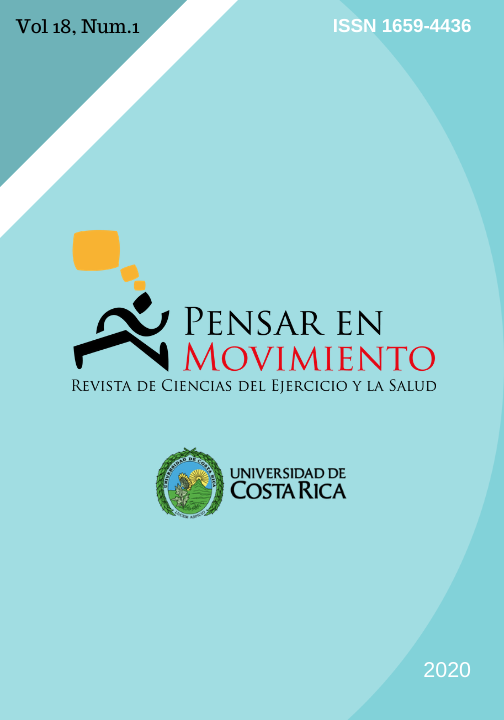Resumen
El principal objetivo del estudio es analizar el efecto agudo del entrenamiento en trampolín (ET) sobre la estabilidad, altura de salto y velocidad de carrera en 20 m de porristas. Se reclutaron 53 sujetos (18 hombres y 35 mujeres), que pertenecen al programa de porrismo Pura Vida Athletics (Tibás, Costa Rica). Se conformaron aleatoriamente tres grupos: grupo trampolín (GT), grupo control (GC) y grupo entrenamiento normal (GEN). El GT realizó un entrenamiento de trampolín (ET) tradicional (duración aproximada de 45 min; intensidad de 75-85% de la frecuencia cardiaca máxima). Se realizaron mediciones pre test y post test de la estabilidad (centro de presión), velocidad en 20 m y altura de salto (CMJ). Respecto a la estabilidad, en bipedestación el GT empeoró significativamente (p<0.05*) comparado con el GC y, en las posiciones liberty, awesome y arebesque, el GT empeoró significativamente (p<0.05*) comparado con el GC y GEN. La altura del CMJ del GT fue significativamente menor (p<0.05*) con respecto al GEN, pero no del GC. La velocidad en 20 m del GT disminuyó significativamente (p<0.05*), mientras que el GC (p>0.05) y el GEN (p>0.05) no tuvieron un cambio significativo. Como conclusiones, se evidenció una disminución significativa de la estabilidad del GT en bipedestación y, en los elementos de stunt liberty, awesome y arebesque. La altura del CMJ del GT tuvo una disminución no significativa. La velocidad en 20 m del GT fue significativamente menor después del ET.
Citas
Arabatzi, F. (2018). Adaptations in movement performance after plyometric training on mini-trampoline in children. The Journal of Sports Medicine and Physical Fitness, 58(1-2), 66-72. doi: https://doi.org/10.23736/S0022-4707.16.06759-1
Aragão, F. A., Karamanidis, K., Vaz, M. A. y Arampatzis, A. (2011). Mini-trampoline exercise related to mechanisms of dynamic stability improves the ability to regain balance in elderly. Journal of Electromyography and Kinesiology, 21(3), 512-518. doi: https://doi.org/10.1016/j.jelekin.2011.01.003
Aragón, L. F. (2000). Evaluation of Four Vertical Jump Tests: Methodology, Reliability, Validity, and Accuracy. Measurement in Physical Education and Exercise Science, 4(4), 215-228. doi: https://doi.org/10.1207/S15327841MPEE0404_2
Arampatzis, A., Stafilidis, S., Morey-Klapsing, G. y Brüggemann, G. P. (2004). Interaction of the human body and surfaces of different stiffness during drop jumps. Medicine & Science in Sports and Exercise, 36(3), 451-459. doi: https://doi.org/10.1249/01.MSS.0000117166.87736.0A
Atilgan, O. E. (2013). Effects of trampoline training on jump, leg strength, static and dynamic balance of boys. Science of Gymnastics Journal, 5(2), 15-25. Recuperado de https://search.proquest.com/openview/acc3c8f97227f81d917e05672ba697c0/1?pq-origsite=gscholar&cbl=666318
Bendiksen, M., Bischoff, R., Randers, M., Mohr, M., Rollo, I., Suetta, C., … Krustrup, P. (2012). The Copenhagen Soccer Test: Physiological Response and Fatigue Development. Medicine & Science in Sports & Exercise, 44(8), 1595-1603. doi: https://doi.org/10.1249/MSS.0b013e31824cc23b
Bradshaw, E. J. y Le Rossignol, P. (2004). Anthropometric and biomechanical field measures of floor and vault ability in 8 to 14 year old talent-selected gymnasts. Sports Biomechanics, 3(2), 249-262. doi: https://doi.org/10.1080/14763140408522844
Granacher, U., Muehlbauer, T., Maestrini, L., Zahner, L. y Gollhofer, A. (2011). Can balance training promote balance and strength in prepubertal children? Journal of Strength and Conditioning Research, 25(6), 1759-1766. doi: https://doi.org/10.1519/JSC.0b013e3181da7886
International Cheer Union [ICU]. (23 de Marzo de 2019). History of Cheerleading. Recuperado de http://cheerunion.org/home/
Jensen, P., Scott, S., Krustrup, P. y Mohr, M. (2013). Physiological responses and performance in a simulated trampoline gymnastics competition in elite male gymnasts. Journal Of Sports Sciences, 31(16), 1761-1769. Recuperado de https://www.ncbi.nlm.nih.gov/pubmed/23876055
Karakollukçu, M., Aslan, C. S., Paoli, A., Bianco, A. y Sahin, F. N. (2015). Effects of mini trampoline exercise on male gymnasts’ physiological parameters: A pilot study. The Journal Of Sports Medicine And Physical Fitness, 55(7-8), 730-734. Recuperado de https://www.ncbi.nlm.nih.gov/pubmed/24921617
Krustrup, P., Mohr, M., Amstrup, T., Rysgaard, T., Johansen, J., Steensberg, A., … Bangsbo, J. (2003). The Yo-Yo Intermittent Recovery Test: Physiological Response, Reliability, and Validity. Medicine & Science in Sports & Exercise, 35(4), 697-705. doi: https://doi.org/10.1249/01.MSS.0000058441.94520.32
Mohr, M., Krustrup, P., Nielsen, J. J., Nybo, L., Rasmussen, M. K., Juel, C. y Bangsbo, J. (2007). Effect of two different intense training regimens on skeletal muscle ion transport proteins and fatigue development. American Journal of Physiology-Regulatory, Integrative and Comparative Physiology, 292(4), R1594-R1602. doi: https://doi.org/10.1152/ajpregu.00251.2006
Mohr, M., Nielsen, J. J. y Bangsbo, J. (2011). Caffeine intake improves intense intermittent exercise performance and reduces muscle interstitial potassium accumulation. Journal of Applied Physiology, 111(5), 1372-1379. doi: https://doi.org/10.1152/japplphysiol.01028.2010
Mohr, M., Rasmussen, P., Drust, B., Nielsen, B. y Nybo, L. (2006). Environmental heat stress, hyperammonemia and nucleotide metabolism during intermittent exercise. European Journal of Applied Physiology, 97(1), 89-95. doi: https://doi.org/10.1007/s00421-006-0152-60
Nagymate, G., Vamos, B. y Kiss, R. M. (2016). Validation of the Nintendo Wii Balance Board for stabilometry measurements. 2016 International Symposium on Small-scale Intelligent Manufacturing Systems (SIMS), 111-114. doi: https://doi.org/10.1109/SIMS.2016.7802909
Prieske, O., Muehlbauer, T., Mueller, S., Krueger, T., Kibele, A., Behm, D. G. y Granacher, U. (2013). Effects of surface instability on neuromuscular performance during drop jumps and landings. European Journal of Applied Physiology, 113(12), 2943-2951. doi: https://doi.org/10.1007/s00421-013-2724-6
Rojas-Barrionuevo, N. A., Vernetta-Santana, M., Alvariñas-Villaverde, M. y López-Bedoya, J. (2017). Acute effect of acrobatic jumps on different elastic platforms in the muscle response evaluated through tensiomyography. Journal of Human Sport & Exercise, 12(3), 728-741. doi: https://doi.org/10.14198/jhse.2017.123.17
Scaglioni-Solano, P. y Aragón-Vargas, L. F. (2014). Validity and reliability of the Nintendo Wii Balance Board to assess standing balance and sensory integration in highly functional older adults. International Journal of Rehabilitation Research, 37(2), 138-143. doi: https://doi.org/10.1097/MRR.0000000000000046
Stanton, R., Hayman, M., Humphris, N., Borgelt, H., Fox, J., Del Vecchio, L. y Humphries, B. (2016). Validity of a Smartphone-Based Application for Determining Sprinting Performance. Journal of Sports Medicine, 2016, 1-5. doi: https://doi.org/10.1155/2016/7476820
Witassek, C., Nitzsche, N. y Schulz, H. (2018). The Effect of Several Weeks of Training with Mini-Trampolines on Jump Performance, Trunk Strength and Endurance Performance. German Journal of Sports Medicine, 69(2), 38-44. doi: https://doi.org/10.5960/dzsm.2018.318



